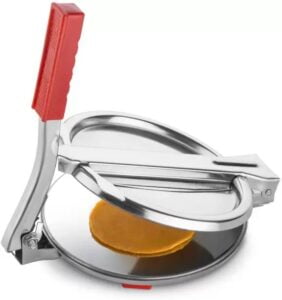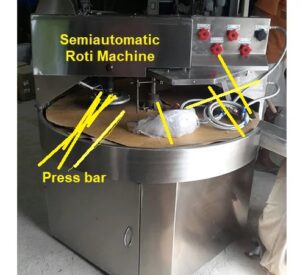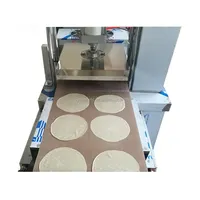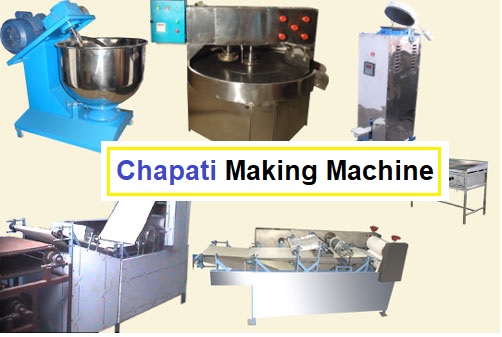Chapati-making Machine
- Chapati, also known as roti, is a staple food in many parts of the world, particularly in South Asia.
- It is a type of flatbread made from wheat flour, and it is typically served with curry, vegetables, or meat.
- Making chapatis can be a time-consuming and labor-intensive process, particularly if you need to make large quantities for a family or an event. Fortunately, there is a solution to this problem: the chapati-making machine.
Advantages of Using a Chapati-making Machine
A chapati-making machine is a device that automates the process of making chapatis. It is a machine that kneads the dough, flattens it into thin disks, and cooks them to perfection. The machine is available in different sizes and capacities to suit various needs.
Here are some of the advantages of using a chapati-making machine:
- Time-Saving: Making chapatis by hand can be time-consuming, particularly if you need to make large quantities. Using a chapati making machine can save you a lot of time and effort, allowing you to make more chapatis in less time.
- Consistency: One of the challenges of making chapatis by hand is achieving a consistent thickness and size. With a chapati making machine, you can ensure that each chapati is of the same size and thickness, resulting in a more uniform and professional-looking product.
- Hygiene: Making chapatis by hand can be a messy process, and there is a risk of contamination from dust, dirt, or other impurities. A chapati making machine eliminates this risk, ensuring that the dough and the finished product remain clean and hygienic.
- Cost-Effective: While a chapati-making machine can be an expensive investment, it can save you money in the long run by reducing labor costs and minimizing wastage.

How to use a chapati-making machine
When using a chapati-making machine, it is essential to follow the manufacturer’s instructions carefully. Here are the basic steps involved in using a chapati-making machine:
- Add the required amount of flour and water to the machine’s kneading chamber.
- Set the machine to knead the dough for the recommended amount of time.
- Once the dough is ready, remove it from the machine and divide it into small balls.
- Place each ball in the machine’s pressing chamber, and flatten it into a thin disk.
- The machine will then cook the chapati, typically for a few seconds on each side.
- Remove the chapati from the machine and repeat the process with the remaining balls of dough.
Types of chapati-making Machine
There are various types of chapati-making machines available in the market. Here are some of the most common types:
Semi-Automatic Chapati-Making Machine:
- This type of machine is designed for small-scale production and is suitable for home use, small restaurants, or catering businesses.
- It requires some manual intervention, such as placing the dough ball on the pressing plate and removing the cooked chapati from the machine.

Fully Automatic Chapati Making Machine:
- This machine is designed for large-scale production and is suitable for industrial use. It can produce hundreds or even thousands of chapatis per hour, with minimal manual intervention required. The machine can knead the dough, flatten it into disks, cook the chapatis, and even stack them for packaging.

A fully automatic chapati making machine is a high-tech appliance that automates the entire process of making chapatis. This machine is designed for large-scale production and is suitable for use in industrial settings. It can produce hundreds or even thousands of chapatis per hour, with minimal manual intervention required.
- A fully automatic chapati making machine typically consists of several components:
-
- Dough Kneading Unit: This unit consists of a motor and a bowl for kneading the dough. The motor rotates the bowl to knead the dough evenly.
- Dough Ball Making Unit: This unit forms the dough into small balls of the required size.
- Dough Ball Feeding Unit: This unit feeds the dough balls into the pressing unit.
- Pressing Unit: This unit flattens the dough ball into a round disk of the required size and thickness.
- Cooking Unit: This unit cooks the chapati by heating it on both sides for a few seconds.
- Cooling and Stacking Unit: This unit cools the chapati and stacks them for packaging.
- The fully automatic chapati making machine works by first preparing the dough in the kneading unit. The dough is then divided into small balls of the required size by the ball making unit. These dough balls are then fed into the pressing unit, where they are flattened into disks. The cooking unit then cooks the chapati on both sides for a few seconds. Finally, the cooling and stacking unit cools the chapati and stacks them for packaging.
- The machine is controlled by a computer program that can be customized to produce chapatis of different sizes, thicknesses, and textures. The chapatis produced by the machine are consistent in size and texture, ensuring that each one is of high quality.
- Fully automatic chapati making machines are highly efficient and can produce large quantities of chapatis quickly and consistently. They are ideal for use in commercial kitchens, large restaurants, and industrial settings where large quantities of chapatis are required.
Electric Chapati-Making Machine
- This type of machine uses electricity to power the motor that kneads the dough and flattens it into disks.
- It is suitable for home use, small restaurants, or catering businesses.

Hydraulic Chapati-Making Machine
- This machine uses hydraulic pressure to knead the dough and flatten it into disks.
- It is suitable for medium to large-scale production and is often used in commercial kitchens or factories.

Pneumatic Chapati Making Machine:
- This type of machine uses compressed air to flatten the dough into disks. It is suitable for medium to large-scale production and is often used in commercial kitchens or factories.
- Automatic Roti-Making Machine: This machine is designed specifically for making rotis, a type of Indian bread similar to chapatis. It can knead the dough, flatten it into disks, cook the rotis, and stack them for packaging.
Summary
- A chapati-making machine is an excellent investment for anyone who makes chapatis regularly. It can save you time, effort, and money, while also ensuring consistency and hygiene. If you’re considering buying a chapati-making machine, be sure to research your options carefully and choose a model that suits your needs and budget
- When choosing a chapati-making machine, it is essential to consider factors such as production capacity, power source, and ease of operation. It is also important to choose a machine that is durable, easy to maintain, and comes with a warranty
